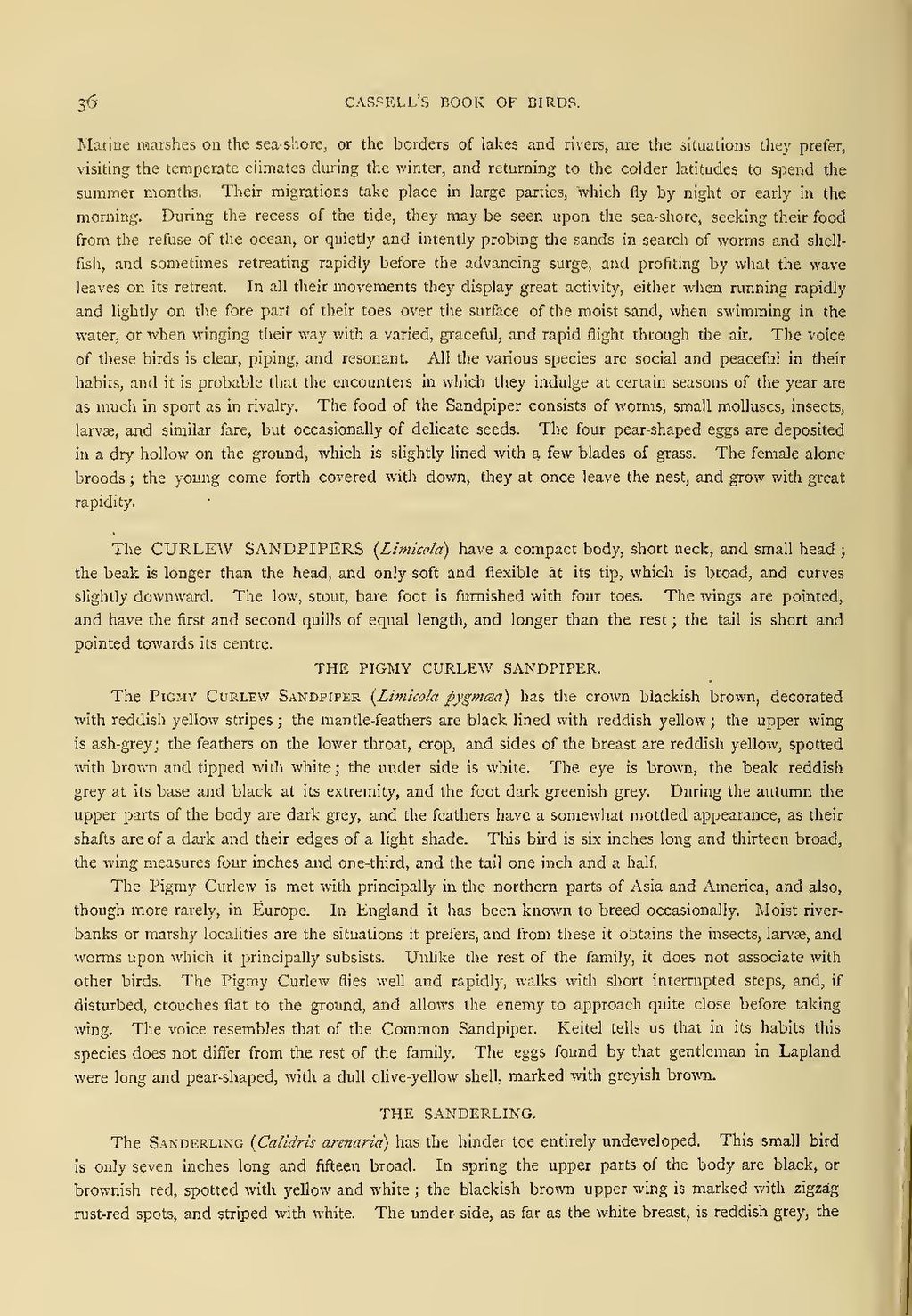Marine marshes on the sea-shore, or the borders of lakes and rivers, are the situations they prefer, visiting the temperate climates during the winter, and returning to the colder latitudes to spend the summer months. Their migrations take place in large parties, which fly by night or early in the morning. During the recess of the tide, they may be seen upon the sea-shore, seeking their food from the refuse of the ocean, or quietly and intently probing the sands in search of worms and shell-fish, and sometimes retreating rapidly before the advancing surge, and profiting by what the wave leaves on its retreat. In all their movements they display great activity, either when running rapidly and lightly on the fore part of their toes over the surface of the moist sand, when swimming in the water, or when winging their way with a varied, graceful, and rapid flight through the air. The voice of these birds is clear, piping, and resonant. All the various species are social and peaceful in their habits, and it is probable that the encounters in which they indulge at certain seasons of the year are as much in sport as in rivalry. The food of the Sandpiper consists of worms, small molluscs, insects, larvæ, and similar fare, but occasionally of delicate seeds. The four pear-shaped eggs are deposited in a dry hollow on the ground, which is slightly lined with a few blades of grass. The female alone broods; the young come forth covered with down, they at once leave the nest, and grow with great rapidity.
The CURLEW SANDPIPERS (Limicola) have a compact body, short neck, and small head; the beak is longer than the head, and only soft and flexible at its tip, which is broad, and curves slightly downward. The low, stout, bare foot is furnished with four toes. The wings are pointed, and have the first and second quills of equal length, and longer than the rest; the tail is short and pointed towards its centre.
THE PIGMY CURLEW SANDPIPER.
The Pigmy Curlew Sandpiper (Limicola pygmæa) has the crown blackish brown, decorated with reddish yellow stripes; the mantle-feathers are black lined with reddish yellow; the upper wing is ash-grey; the feathers on the lower throat, crop, and sides of the breast are reddish yellow, spotted with brown and tipped with white; the under side is white. The eye is brown, the beak reddish grey at its base and black at its extremity, and the foot dark greenish grey. During the autumn the upper parts of the body are dark grey, and the feathers have a somewhat mottled appearance, as their shafts are of a dark and their edges of a light shade. This bird is six inches long and thirteen broad, the wing measures four inches and one-third, and the tail one inch and a half.
The Pigmy Curlew is met with principally in the northern parts of Asia and America, and also, though more rarely, in Europe. In England it has been known to breed occasionally. Moist river-banks or marshy localities are the situations it prefers, and from these it obtains the insects, larvæ, and worms upon which it principally subsists. Unlike the rest of the family, it does not associate with other birds. The Pigmy Curlew flies well and rapidly, walks with short interrupted steps, and, if disturbed, crouches flat to the ground, and allows the enemy to approach quite close before taking wing. The voice resembles that of the Common Sandpiper. Keitel tells us that in its habits this species does not differ from the rest of the family. The eggs found by that gentleman in Lapland were long and pear-shaped, with a dull olive-yellow shell, marked with greyish brown.
THE SANDERLING.
The Sanderling (Calidris arenaria) has the hinder toe entirely undeveloped. This small bird is only seven inches long and fifteen broad. In spring the upper parts of the body are black, or brownish red, spotted with yellow and white; the blackish brown upper wing is marked with zigzag rust-red spots, and striped with white. The under side, as far as the white breast, is reddish grey, the
